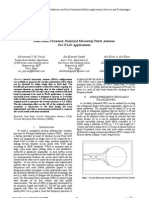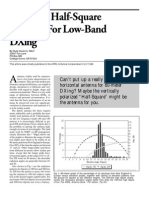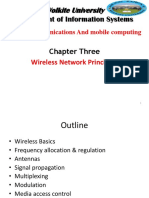1.chapter 1
1.chapter 1
Uploaded by
Mac BallesterosCopyright:
Available Formats
1.chapter 1
1.chapter 1
Uploaded by
Mac BallesterosOriginal Title
Copyright
Available Formats
Share this document
Did you find this document useful?
Is this content inappropriate?
Copyright:
Available Formats
1.chapter 1
1.chapter 1
Uploaded by
Mac BallesterosCopyright:
Available Formats
CHAPTER I Background of the Design
Introduction The fast-phased changes in terms of mans need of wider and innovative communication system open up desires to converse in a convenient and efficient transformation on wireless system. Tracing back history, early form of wireless communication has been seen from pre-modern man when they began yelling from mountains peak and foot in order to transfer messages. Other historical examples include Chinese fire signals along the Great Wall of China to warn the defenders of approaching invaders and smoke signals of Native Americans used in warfare (Javadi, K. 2005). These simple forms of communication serve as the initial inspirations for the ideas of today. The progress of wireless
communications developed from discovery of physical phenomena, rapidly improved within the span of two centuries, and continues to grow at an astonishing pace into the future. Wireless Communication had several kinds, one of which was the Microwave Communication the transmission of signals via radio using a series of microwave towers. Microwave communication is known as a form of "line of sight" communication, because there must be no obstruction in the transmission of data between these towers for signals to be properly sent and received. It was mainly used as a backbone for large networks like in television, data and
telephony. One good application of this type is a cellular telecommunication backbone which was projected in this design. An effective and reliable point-to-point Line-of-Sight (LOS) communication system will be implemented in Misamis Occidental for this design. The sites were carefully chosen and the transmission paths were calculated to have 99.999999% reliability throughout the whole system. The terrain and soil types in the said location were also considered in order to obtain the requirements.
Objectives of the design
The design has the following objectives: To establish a comprehensive and efficient point-to-point connection that will serve as a backbone of cellular system. To attain a high-quality transmission with 99.999999% reliability in the selected locations To limit the sites reflection point that would result to the unwanted loss of line To provide communication services for the citizens of Misamis Occidental, Philippines To obtain a line-of-sight (LOS) communication between two antennas without having obstruction To be able to achieve an interactive environment in the province of Misamis Occidental through technological innovation
Significance of the study
This design would be of great help for electronics and communications engineering students who intend to prioritize microwave communication system planning. Theories, facts and practical applications were done in order to obtain the best possible results in establishing a reliable means of wireless communication. The proposed design covered the province of Misamis Occidental using microwave technology to provide services involving cellular connectivity with reliable signal. In such, residents of the said province will be able to communicate easily and effectively for any means. The possible losses in each hop were computed to be able to provide reliable communication. Moreover, the design will aid the students to be ready in facing challenges for their career in wireless communication in time that they were in the outside world.
Scopes and Delimitations Scopes This microwave communication system design is subjected to the following: The province of Misamis Occidental. Gathering of initial data included maps from National Mapping to trail the succeeding steps. Maximum distance of 10 kilometers between two microwave communication links were considered in the path analysis. All necessary calculations which includes the site coordinates, great circle distance, antenna height and orientation, vertical panning, angle and reflection point, losses, system analysis, reliability and
unavailability were included. The frequency is around 18 Ghz and its allocation to every microwave sites were based on the frequency chart provided by National Telecommunications Commission. Equipment specifications essential to conclude that reliability were reached. Rough approximations of the overall system costing were also done.
Delimitations This microwave communication system design is subjected to the following:
Civil works were excluded to the design. Licensing and other permits were not included. Local building codes and restrictions were not considered in the design.
The site was not visited by the designers. The maps from NAMRIA are outdated.
DEFINITION OF TERMS
Absorption energy loss absorbed by the atmospheric elements such as, rain, snow, oxygen, clouds and vapors Attenuation a progressive decrease of signal power or power density as distance increases Bandwidth refers to the range of frequencies the parabolic antenna will radiate effectively Beamwidth the angles created by comparing the half-power points (3dB) on the main radiation lobe to its maximum power point Direct Beam is the center part of the Fresnel zone, wherein most of the microwave signals are transmitted from the transmitter to the receiver or vice-versa Earth Bulge Earths curvature presents loss obstruction and must be compensated using 4/3 earth radius for atmospheric bending of waves Fade Margin allowance for fading; a measure of how much signal attenuation due to multipath and rain fading can be able to accommodate by the radio system Fading is the fluctuation in the signal strength at a receiver and may be rapid or slow, general or frequency-selective First Fresnel Zone the first circular zone nearest to the direct beam Frequency Range the frequency range set by the National Telecommunications Commission (NTC), in which a radio is allowed to control
Fresnel Zone area depicted as concentric circular zones concerning to the direct path of the microwave signals forming as three-dimensional imaginary solid called ellipsoid. Full Duplex capability to transmit and receive in both directions at the same time GHz abbreviation for gigahertz; a measure of frequency equivalent to 1 thousand million (109) cycles per second Hot-Standby also known as protected configuration is the system configuration of a radio in which two sets of circuitry are arranged in tandem, with one back-up mode in case a failure occurs in the operational circuitry. A microprocessor monitors the on-line circuitry and switches to the back-up circuitry if a failure is detected. Input/output Connection the connector type used to interface peripheral digital equipment to a radio Interface the digital boundary of the radio to the peripheral digital equipment Isotropic Received Level signal level at the air interface related to those transmitted by an isotropic source Maximum Power Output the maximum permissible transmitter power output, as specified by governing agency regulations Mb/s abbreviation for megabits per second; equivalent to 1 million (106) digital bits per second Microwave an electromagnetic wave with a wavelength in the range of 0.001 0.3 m, shorter than a normal radio wave but longer than those infrared radiations
Minimum Power Output the minimum permissible transmitter power output, as specified by governing agency regulations Non-Protected the radio configuration in which there is only one transmitter and one receiver Power Output the power of the radio signal as it leaves the RF unit Protected the system configuration of a radio in which two sets, or redundant groups, of components and assemblies are arranged in tandem, with one group in back-up mode in case a failure occurs with the in-service system Sensitivity is a measurement of a receivers ability to receive weak signals System Gain sum of the transmitter power output and the receiver sensitivity Typical Power Output the suggested transmitter power output, as specified by the governing agency Voice Channel Capacity quantity of digitized voice circuits which can be accommodated by a specified digital line rate Waveguide a hollow metallic conductor used for carrying signal of microwave frequencies from the equipment to the antenna
You might also like
- Radio Propagation For Modern Wireless Systems 0130263737Document272 pagesRadio Propagation For Modern Wireless Systems 0130263737Clive MangwiroNo ratings yet
- ECE105 - Microwave Link DesignDocument55 pagesECE105 - Microwave Link DesignKlinn Cabresos100% (8)
- Terrestrial Microwave Communications SystemDocument112 pagesTerrestrial Microwave Communications SystemAnonymous 5ZR8rH3No ratings yet
- Microwave RadioDocument5 pagesMicrowave RadioArman Ul NasarNo ratings yet
- Microwave Radio Relay and LinksDocument12 pagesMicrowave Radio Relay and Linksvarun8tNo ratings yet
- MICROWAVE COMMUNICATION SYSTEM DESIGN by Kathleen Sales, Pia Libutan, Gem Cabanos & Pau PantonDocument13 pagesMICROWAVE COMMUNICATION SYSTEM DESIGN by Kathleen Sales, Pia Libutan, Gem Cabanos & Pau PantonKathleen Sales100% (1)
- Cell Coverage Area and Link Budget Calculations in GSM SystemDocument7 pagesCell Coverage Area and Link Budget Calculations in GSM SystemMustaf MohamedNo ratings yet
- Course Material For Module 2 McsDocument22 pagesCourse Material For Module 2 McsNoble VargheseNo ratings yet
- Microwave Design Linking Laoag and PagudpudDocument119 pagesMicrowave Design Linking Laoag and PagudpudRexter Reeve RocaporNo ratings yet
- Microwave Links-1Document20 pagesMicrowave Links-1Not SureNo ratings yet
- MWC QB 2020Document18 pagesMWC QB 2020S MaheswariNo ratings yet
- Introduction To MicrowaveDocument13 pagesIntroduction To MicrowaveEmmanuel AlapNo ratings yet
- Name: Bitrus Atang Reg No: AKP/ENG/EET/HND 2008/019 Course: Digital Communication IIIDocument9 pagesName: Bitrus Atang Reg No: AKP/ENG/EET/HND 2008/019 Course: Digital Communication IIIPatrick AfefohNo ratings yet
- PageDocument41 pagesPagetharindu pathirajaNo ratings yet
- Microwave DesignDocument31 pagesMicrowave Designjomel manalastasNo ratings yet
- Lecture 01Document10 pagesLecture 01ambush_143No ratings yet
- WC QBDocument23 pagesWC QBsandeep kumar yadavNo ratings yet
- 1576330847Document14 pages1576330847nadafaaliya1No ratings yet
- Lecture 1 - Microwave SystemsDocument53 pagesLecture 1 - Microwave SystemsAbdul SuboorNo ratings yet
- 40ec801 Adhoc and Sensor Networks Objective(s)Document20 pages40ec801 Adhoc and Sensor Networks Objective(s)SureshNo ratings yet
- LASER CommunicationDocument16 pagesLASER CommunicationarjunknarayanNo ratings yet
- Site SelectionDocument3 pagesSite SelectionGray FullbusterNo ratings yet
- Unit 1 - Mobile Communication - WWW - Rgpvnotes.inDocument11 pagesUnit 1 - Mobile Communication - WWW - Rgpvnotes.inRohit kumarNo ratings yet
- Rahu FinalDocument14 pagesRahu FinalkirankumarikanchanNo ratings yet
- LInk Budget GSMDocument12 pagesLInk Budget GSMFebri DoangNo ratings yet
- Wireless Communication Notes PDFDocument212 pagesWireless Communication Notes PDFHemlata PanwarNo ratings yet
- Thesis Topics On Microwave CommunicationDocument8 pagesThesis Topics On Microwave Communicationmichellesinghseattle100% (2)
- 5.3 Tuorial Co5Document14 pages5.3 Tuorial Co5HarreniNo ratings yet
- Research ArticleDocument15 pagesResearch ArticleSrikar DNo ratings yet
- Mobile and Wireless NetworkDocument28 pagesMobile and Wireless NetworkKoBori TeNo ratings yet
- Final ReportDocument57 pagesFinal ReportJay BavarvaNo ratings yet
- 2013 August 7 Microwave Radio PrinciplesDocument144 pages2013 August 7 Microwave Radio PrinciplesThomas Samuels100% (1)
- Mobile Computing Synopsis UNIT-1: Generations of Wireless Mobile SystemsDocument25 pagesMobile Computing Synopsis UNIT-1: Generations of Wireless Mobile SystemsNuthanKumarReddyNo ratings yet
- Design and Fabrication of A Micro-Strip Antenna For Wi-Max ApplicationsDocument54 pagesDesign and Fabrication of A Micro-Strip Antenna For Wi-Max ApplicationsaylokolloNo ratings yet
- CMC r20 IV I Lecture NotesDocument159 pagesCMC r20 IV I Lecture NotesSivadharani DasareddygariNo ratings yet
- History: Radio WavesDocument3 pagesHistory: Radio WavesPamela McmahonNo ratings yet
- Mobile TelecommunicationDocument79 pagesMobile Telecommunicationteguia donatienNo ratings yet
- Handout - 21 (CT)Document16 pagesHandout - 21 (CT)Mohian RahmanNo ratings yet
- Broadband Millimeter Wave MIMODocument5 pagesBroadband Millimeter Wave MIMOManjusha SreedharanNo ratings yet
- Wire Chap1Document34 pagesWire Chap1eyasu abebeNo ratings yet
- Optical Fiber in BDDocument5 pagesOptical Fiber in BDReshma ParvinNo ratings yet
- Cellular & Mobile CommunicationsDocument77 pagesCellular & Mobile CommunicationsKhushiNo ratings yet
- Basic ElectronicsDocument20 pagesBasic ElectronicsDarshan Iyer NNo ratings yet
- Wrls ch5Document22 pagesWrls ch5ebrahimtufa209No ratings yet
- 12 Physics Notes Ch15 Communication SystemsDocument4 pages12 Physics Notes Ch15 Communication SystemsMayank Saini100% (1)
- TelecommunicationDocument74 pagesTelecommunicationAshok PoudelNo ratings yet
- 03 16030703 PDFDocument20 pages03 16030703 PDFJamal NasirNo ratings yet
- Cellular ConceptDocument130 pagesCellular Conceptsanjeevsoni64No ratings yet
- Digital Radio SystemDocument24 pagesDigital Radio SystemJayesh SinghalNo ratings yet
- Unit 1 MANET NotesDocument24 pagesUnit 1 MANET NotesSrie Teja N150232No ratings yet
- 22f4 PDFDocument7 pages22f4 PDFAnonymous tG4YlJqdyNo ratings yet
- 1G-4G - IntroductionDocument53 pages1G-4G - Introductionpopescubianca2010No ratings yet
- Communication QuestionareDocument19 pagesCommunication QuestionarePriyanka DattaNo ratings yet
- Cellular Mobile Radio Systems (Husni Hammuda) 1997Document211 pagesCellular Mobile Radio Systems (Husni Hammuda) 1997Ольга КалмыковаNo ratings yet
- TelemetryDocument34 pagesTelemetrySamuel AdamuNo ratings yet
- Fifth Semester Wireless Communication Two Marks With Answers Regulation 2013Document12 pagesFifth Semester Wireless Communication Two Marks With Answers Regulation 2013PRIYA RAJI78% (9)
- Unit - Vi Communication and Computer Systems 1. Draw The Basic Block Diagram of Communication System?Document14 pagesUnit - Vi Communication and Computer Systems 1. Draw The Basic Block Diagram of Communication System?vinothNo ratings yet
- Radio Propagation and Adaptive Antennas for Wireless Communication Networks: Terrestrial, Atmospheric, and IonosphericFrom EverandRadio Propagation and Adaptive Antennas for Wireless Communication Networks: Terrestrial, Atmospheric, and IonosphericNo ratings yet
- Signal Integrity: From High-Speed to Radiofrequency ApplicationsFrom EverandSignal Integrity: From High-Speed to Radiofrequency ApplicationsNo ratings yet
- Dual Band Circularly Polarized Microstrip Patch Antenna For Wi-Fi ApplicationsDocument8 pagesDual Band Circularly Polarized Microstrip Patch Antenna For Wi-Fi ApplicationsishajainemorNo ratings yet
- Build A 9dB, 70cm Collinear AntennaDocument2 pagesBuild A 9dB, 70cm Collinear AntennaStephen Dunifer100% (1)
- 1.5GHz Negative Impedance Converter PaperDocument3 pages1.5GHz Negative Impedance Converter PaperNestor Alberto EscalaNo ratings yet
- Antenna Half Square ArrayDocument8 pagesAntenna Half Square Arraycarlos_gomes_31100% (1)
- Vi-28 Specification For The Master Antenna Television (Matv) SystemDocument5 pagesVi-28 Specification For The Master Antenna Television (Matv) SystemkmleongmyNo ratings yet
- Chapter 3-Wireless Network PrinciplesDocument84 pagesChapter 3-Wireless Network PrinciplesEbisa Chemeda100% (1)
- n6nb Com Quagi HTM PDFDocument13 pagesn6nb Com Quagi HTM PDFMarianesah Bancat QuilabNo ratings yet
- Microstrip and Printed AntennaDocument266 pagesMicrostrip and Printed Antennabchaitanya_551522No ratings yet
- IEC 61850 Communication in MV SWGRDocument4 pagesIEC 61850 Communication in MV SWGRVishwas KaleNo ratings yet
- Odp-065r12m14jj-G DS 3-0-0Document2 pagesOdp-065r12m14jj-G DS 3-0-0Сергей ФатхретдиновNo ratings yet
- G-2200 Ver2.0Document3 pagesG-2200 Ver2.0ShaunVermaakNo ratings yet
- Radar MCQDocument12 pagesRadar MCQRaju Budigonda71% (14)
- Beam Steering Control System For Low-Cost Phased Array Weather RaDocument220 pagesBeam Steering Control System For Low-Cost Phased Array Weather RaIvan WaakoNo ratings yet
- Microstrip Antenna Arrays: Prof. Girish KumarDocument24 pagesMicrostrip Antenna Arrays: Prof. Girish Kumaramitgh88No ratings yet
- 103510-RF Amplifier For NXP Contactless Reader IC'sDocument21 pages103510-RF Amplifier For NXP Contactless Reader IC'schiase83No ratings yet
- Bhotna TeDocument1 pageBhotna TeBSCNo ratings yet
- Metamaterial-Based Thin Planar Lens Antenna For Spatial Beamforming and Multibeam Massive MIMODocument9 pagesMetamaterial-Based Thin Planar Lens Antenna For Spatial Beamforming and Multibeam Massive MIMOcristianNo ratings yet
- Switch Receiver and Transmitters: Safety InstructionsDocument2 pagesSwitch Receiver and Transmitters: Safety Instructionssaleh67msNo ratings yet
- SARK-110 Antenna Analyzer - Theory of OperationDocument3 pagesSARK-110 Antenna Analyzer - Theory of OperationmodelonreneNo ratings yet
- MTS101# 2GD-21Document2 pagesMTS101# 2GD-21NataliaNo ratings yet
- HP6-7 7Document3 pagesHP6-7 7Bjorn AdikNo ratings yet
- Antenna SpecificationsDocument3 pagesAntenna SpecificationsRobertNo ratings yet
- 643600-Question-Paper-Unified-Physics (P3, Q5a&d Polarization Expt)Document5 pages643600-Question-Paper-Unified-Physics (P3, Q5a&d Polarization Expt)superpoohNo ratings yet
- GNC 250/GNC 250XL/GPS 150XL Installation ManualDocument44 pagesGNC 250/GNC 250XL/GPS 150XL Installation ManualJim Worley100% (1)
- Helical AntennaDocument13 pagesHelical AntennaMohammad Ishtiaque Khan100% (1)
- Parte 1 Fundamentos Electromagneticos Con Matlab - Lonngren & SavovDocument345 pagesParte 1 Fundamentos Electromagneticos Con Matlab - Lonngren & SavovAlbert HernándezNo ratings yet
- ATR451606Document2 pagesATR451606José Alfonso Jiménez CapillaNo ratings yet
- Kaito KA2031 NOAA WthrAlrtRadio Operation ManualDocument1 pageKaito KA2031 NOAA WthrAlrtRadio Operation Manual21st-Century-Goods.comNo ratings yet
- R15 Iii-IDocument9 pagesR15 Iii-IbmkondareddyNo ratings yet
- Compilation of ProblemsDocument10 pagesCompilation of ProblemsCindy AyenNo ratings yet

























































































